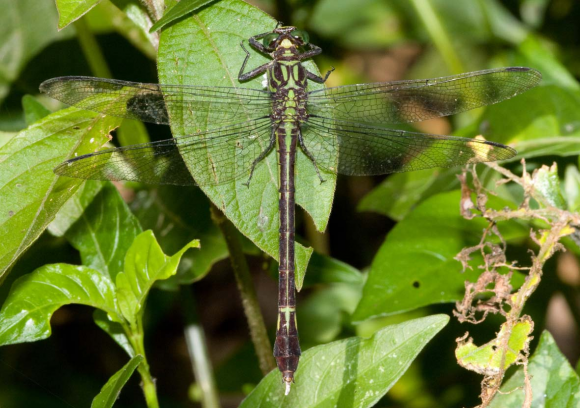Genus Notogomphus Selys, 1858
longlegs
Synonyms:
- scientific: Podogomphus Karsch, 1890 [spinosus]; Nilogomphus Fraser, 1928 [carpenteri = dorsalis]
Type species: Gomphus ruppeli Selys, 1858
Introduction
Endemic to tropical Africa and easily identified by their long and spiny hind femora. Most of the twenty species occur in or near highland areas. They breed in streams and small rivers, the pale species in more open landscapes, and the darker ones more in forest. Adults are fairly sluggish and quite often found perching flatly on rocks and leaves along water courses, or on vegetation distant from water. The species are fairly small to fairly large (hindwing 25-38) and vary widely in markings and appendages. Also within species the extent of dark markings can vary strongly. Although identification may therefore appear complicated, it should be fairly straightforward with the use of illustrations. [Adapted from Dijkstra & Clausnitzer 2014]
Diagnosis
Genus not particularly close to another Gomphid, but similar to most by (a) posterior hamules small, leaving wide gap between them and posterior lamina; (b) Fw discoidal field of rather constant width, at level of node is as wide as at base; (c) Hw with 1-2 cross-veins between sectors of arculus proximal to radial fork, which is symmetrical; (d) anal loop indistinct or of 1-2 cells; (e) anal triangle of 3 cells[3-4]; (f) hind femur longer than breadth of head; (g) S8-9 either without or both with foliations; (h) S10 with smooth dorsum, at most humped; (i) cerci without inner branch, but sometimes with inner tooth; (j) branches of epiproct diverge widely, often extending laterally of cerci (dorsal view), always terminating in simply pointed apices (lateral view). However, Notogomphus is set apart from the rest by (1) posterior hamules only slightly longer than wide, leaning backward rather than forward; (2) hind femur at least reaches to end of S2, often bearing long spines; (3) S10 shorter than S9, basal half not constricted; (4) cerci with ventral tooth near base. [Adapted from Dijkstra & Clausnitzer 2014; this diagnosis not yet verified by author]

Notogomphus leroyi (Schouteden, 1934). Female © Adolfo Cordero
Map citation: Clausnitzer, V., K.-D.B. Dijkstra, R. Koch, J.-P. Boudot, W.R.T. Darwall, J. Kipping, B. Samraoui, M.J. Samways, J.P. Simaika & F. Suhling, 2012. Focus on African Freshwaters: hotspots of dragonfly diversity and conservation concern. Frontiers in Ecology and the Environment 10: 129-134.
References
- Vick, G.S. (2003). Notes on the genus Notogomphus Selys, 1858 in Cameroon with the descriptions of two new species (Anisoptera: Gomphidae). Odonatologica, 32, 47-60. [PDF file]
- Longfield, C. (1936). Studies on African Odonata, with synonymy and descriptions of new species and subspecies. Transactions Royal Entomological Society London, 85, 467-498. [PDF file]
- Pinhey, E.C.G. (1961). Dragonflies (Odonata) of Central Africa. Occasional Papers Rhodes-Livingstone Museum, 14, 1-97. [PDF file]
- Fraser, F.C. (1949). Gomphidae from the Belgian Congo (order Odonata). Revue Zoologie Botanique Africaines, 42, 101-138. [PDF file]
- Schouteden, H. (1934). Annales Musee Congo belge Zoologie 3 Section 2, 3, 1-84. [PDF file]
Citation: Dijkstra, K.-D.B (editor). African Dragonflies and Damselflies Online. http://addo.adu.org.za/ [2024-09-08].


